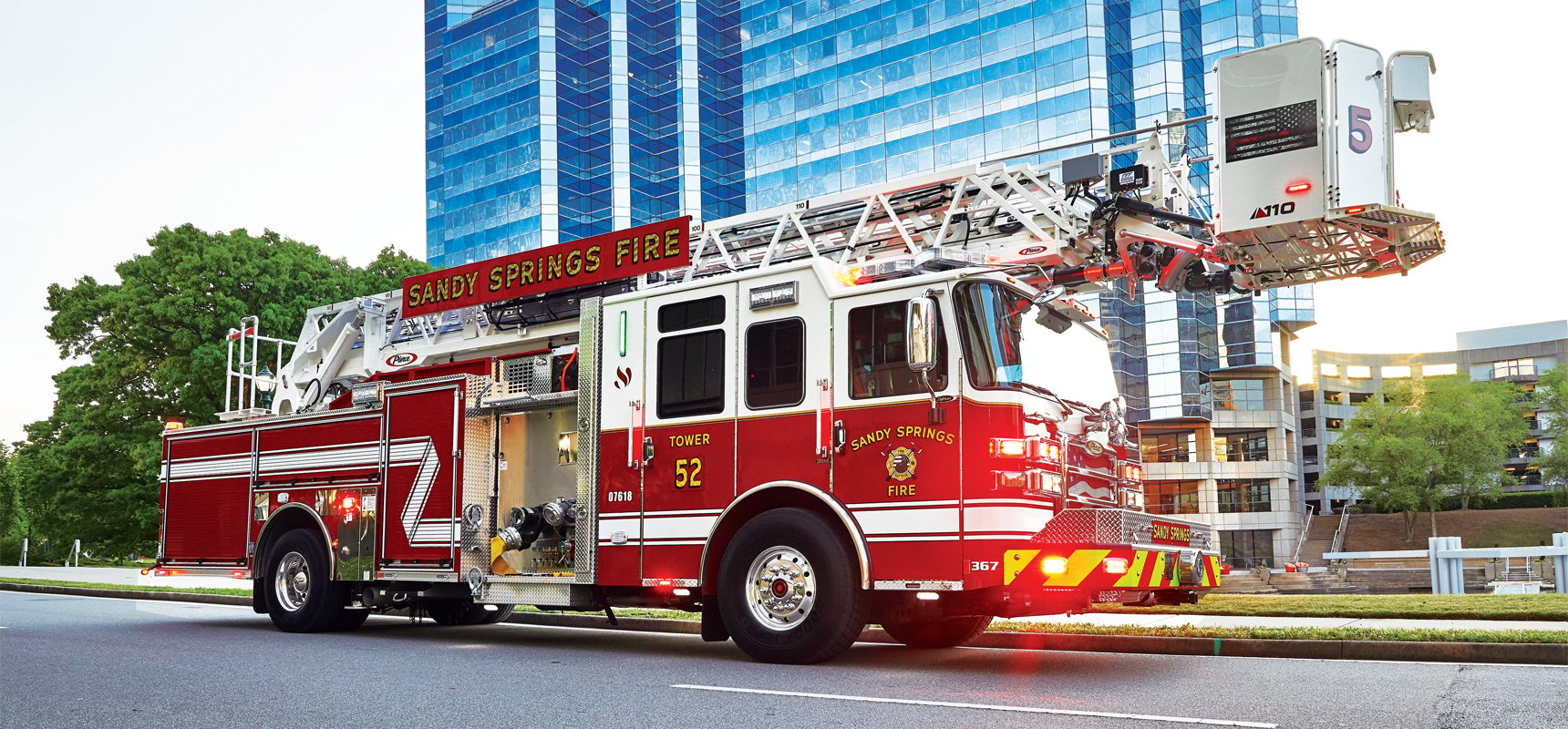
Even though quint fire trucks have been around for more than a century, there is still some confusion about the quint’s operation, capabilities, advantages and requirements.
A quint can be a valuable apparatus for a fire department, but it is important to keep the department’s needs in mind and know what kind of staffing is required to make the best use of the apparatus.
Below, we outline the NFPA requirements of quint fire trucks, show examples and review some important considerations to keep in mind as your fire department considers adding a quint to its fleet.
What is a Quint Fire Truck?
A quint fire truck is an apparatus that combines the equipment capabilities of a ladder truck and the water-pumping ability of a fire engine. As its name implies, it features five main tools to carry out firefighting functions:
- Pump
- Water tank
- Fire hose
- Aerial device
- Ground ladders
The quint has been around since the early 20th century. In fact, the first patent for a quintuple combination pumper date back to 1912. But today’s quints are much more stable, maneuverable and capable than their early counterparts, due in part to a single rear axle configuration, longer reach and a higher-powered engine.
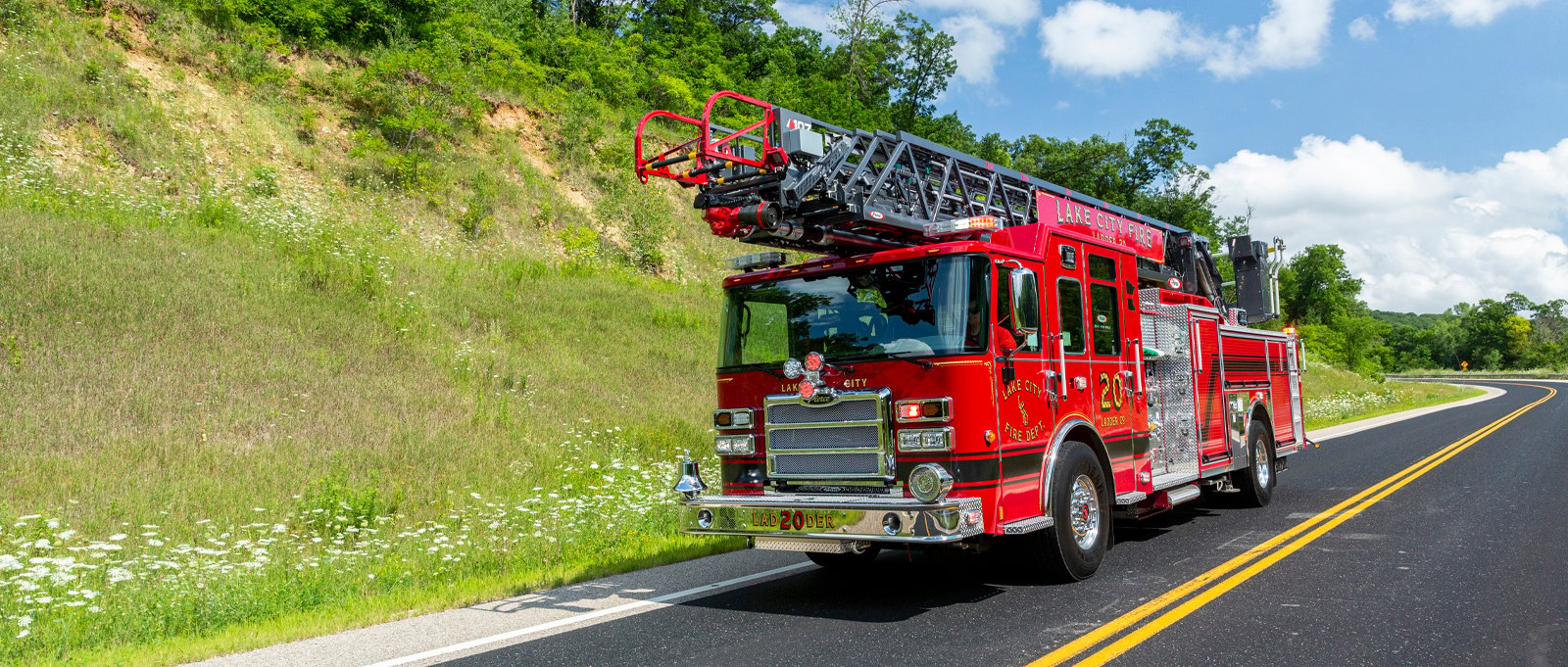
According to the National Fire Protection Association and The Standard for Automotive Fire Apparatus, a modern quint must have:
- A fire pump with a capacity of at least 1,000 gallons per minute.
- A water tank that can hold at least 300 gallons.
- At least 40 cubic feet of enclosed compartment storage.
- Suction hose, including a minimum of 15 feet of soft suction hose or 20 feet of hard suction hose for drafting water.
- An aerial ladder or elevated platform with a permanent waterway.
- 85 feet or more of ground ladders, including at least two extension ladders, one straight ladder equipped with roof hooks and one attic ladder.
- Hose storage area with at least 30 cubic feet of storage able to accommodate a fire hose of 2.5 inches or larger, plus two areas, each a minimum of 3.5 cubic feet, to accommodate 1.5-inch or larger preconnected fire hose lines.
Why Are Quints Beneficial to Fire Departments?
The main benefit of a quint fire apparatus is flexibility. The quint offers a multifaceted tool that can respond to the fire ground and initiate critical support to match the requirements of the emergency.
With a quint fire truck, you have the capability of a ladder truck and pumper engine. As such, the vehicle can lead the initial fire attack while carrying much of the equipment needed by the department, such as an aerial device, water, hose, ground ladders and more.
In addition to emergency response versatility, the quint can also help fire departments save money. The ability to package both a ladder and pumper engine together means that a fire department can buy one vehicle instead of two.
But keep in mind, there is more to consider than just the firefighting tools at your disposal. Determining if a quint fire truck is right for your department starts with understanding your department's needs and mission as well as the personnel available to operate the apparatus.
Is a Quint Fire Truck Right for Your Department?
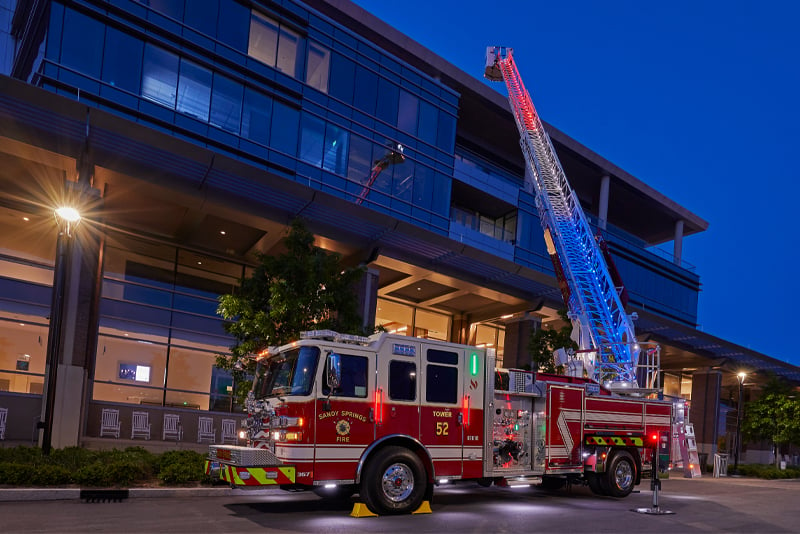
Before deciding if a quint is right for your department and what type of quint you need, it’s important to analyze the needs of the department, including:
- What is the mission of the unit?
- What are the tools and equipment necessary to carry out that mission?
- What are the operational goals of the unit?
- What staff are available to operate the unit?
- What additional training would staff need to use the apparatus to its best potential?
By determining the functionality and tools you require, your fire department can understand if a quint is the best option to meet the needs of your community.
Another vital issue to keep in mind is staffing. Just because a quint combines a ladder truck and pumper engine functions doesn’t mean a department can accomplish all those things at once with a four-person crew. It’s important to adequately staff the apparatus so that all tasks can be accomplished safely. And remember, crew members will need to be cross-trained in both engine and ladder company functions.
Additionally, it’s important to know your geographical region. A test drive can help you determine how the various models will operate in your coverage area. Focus on the tallest structures and areas where the buildings are set back farthest from the road. Consider the space you’ll need for maneuvering and how much reach is required. These considerations will help you design and develop the best unit for your department.
Quint Fire Trucks in Service
Eau Claire Fire Rescue
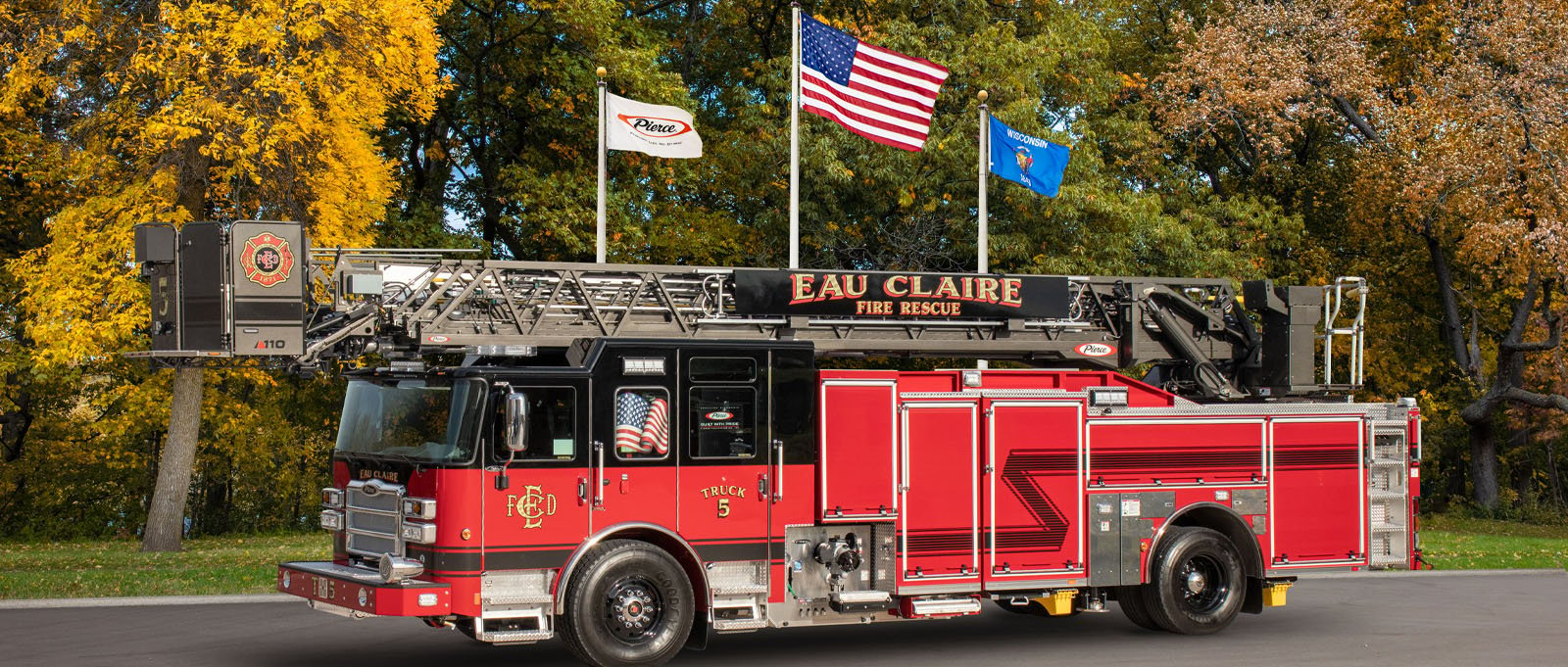
The Eau Claire Fire & Rescue aerial quint fire truck in an Ascendant® 110’ Heavy-Duty Aerial Platform featuring an Enforcer™ chassis. It includes a Husky 3 foam system, a Pierce PUC™ Midship pump and a 500-gallon water tank with the ability to pump 1500 GPM.
Southlake Department of Public Safety - Aerial
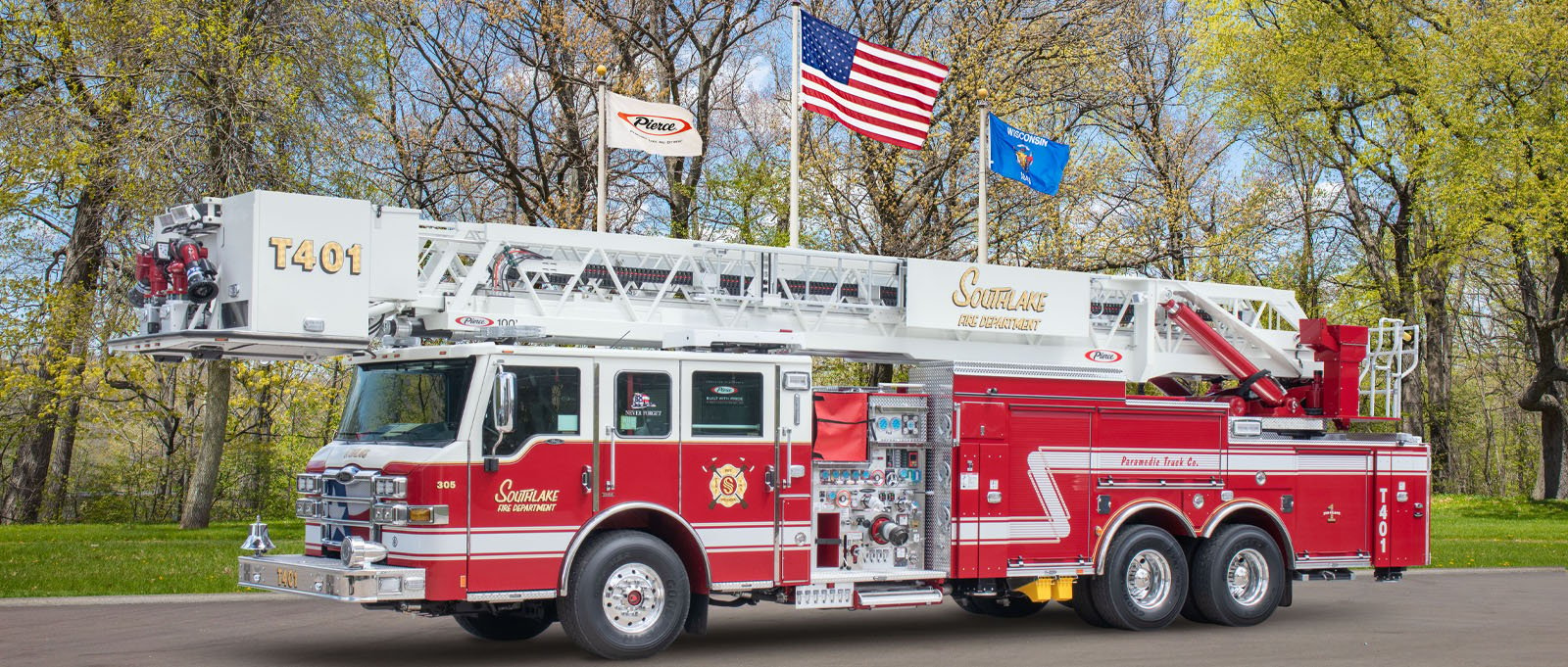
The Southlake Department of Public Safety aerial quint fire truck is a 100’ Heavy-Duty Steel Aerial Platform with a Detroit Diesel DD13 engine. The apparatus includes a Hale Midship pump, a Husky™ 12 foam system and a 300-gallon water tank that can pump 2000 GPM.
Newtown Square Fire Company No.1 - Aerial
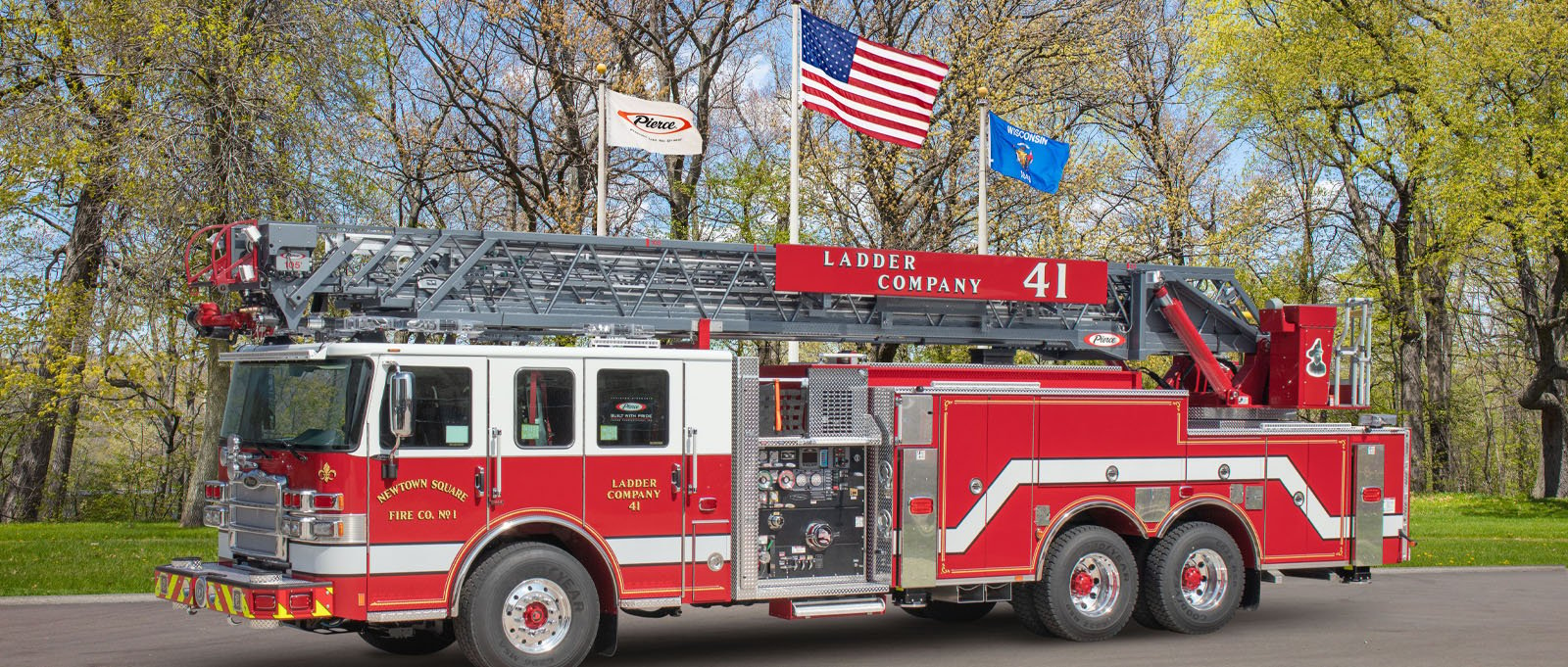
The Newtown Square Fire Company No.1 aerial truck is a 105’ Heavy-Duty Steel Aerial Ladder on an Enforcer™ chassis. The quint fire truck includes a Hale Midship pump and a 500-gallon water tank that can pump 2000 GPM.
Pierce Manufacturing Quint Fire Trucks
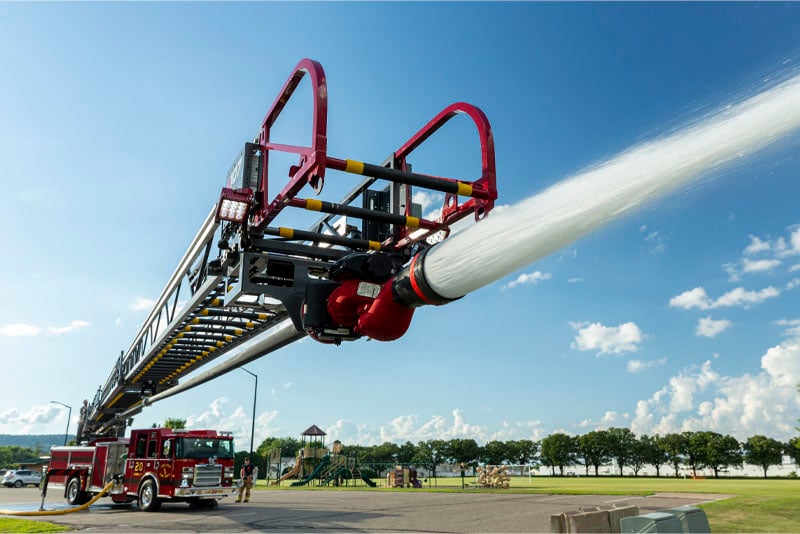
If you decide to purchase a quint fire truck, Pierce Manufacturing is here to meet your needs. Our flexible options will help you acquire the truck that is best for your department, while our 24/7 service and aftermarket support will help keep the truck in top shape for the life of your apparatus.
The quint is available on all Pierce custom chassis, except the Saber, and it can be tailored to Pierce’s 75-foot, 100-foot, 105-foot and 107-foot aerial ladder product lines. Pierce developed the 107-foot aerial ladder to increase the horizontal reach to over 100 feet, giving staff a full operational advantage when fighting fires with larger setbacks while still meeting the equipment requirements for a quint. Quint trucks are also available with both rear-mount platform and mid-mount platforms.
| Ladders Comparison | ||||||||||||
| Custom Chassis | Ladder Reach | Operating Range | Payload Capacities | Wind Rating | Flow Capacity | Stabilizers | Stabilizer Spread | Rear Axle | Tank Capacities | Pump Range | Hosebed Capacities | |
|---|---|---|---|---|---|---|---|---|---|---|---|---|
| 75’ Heavy-Duty Aluminum Ladder | Enforcer™, Impel®, Velocity® | 75' Vertical 67' 9" Horizontal |
-8° to 76° | 750 lb dry 500 lb wet |
Up to 35 mph | Up to 1,500 gpm | 1 set of H-style | 16' | Single | Up to 500 gallons | Waterous, Hale, Darley Midship, PTO, PUC™ | Up to 1,000' of 5" hose |
| 75’ Heavy-Duty Steel Ladder | Enforcer™, Impel®, Velocity® | 75' Vertical 67' Horizontal |
-5° to 75° | 500 lb dry 500 lb wet |
Up to 50 mph | Up to 1,000 gpm | 1 set of H-style | 16' | Single or Tandem | Up to 500 gallons | Waterous, Hale, Darley Midship, PTO, PUC™ | Up to 1,000' of 5" hose |
| 100’ Heavy-Duty Aluminum Ladder | Enforcer™, Velocity® | 100' Vertical 91' 7" Horizontal |
-8° to 76° | 750 lb dry 500 lb wet |
Up to 35 mph | Up to 1,500 gpm | 2 sets of H-style | 12' | Tandem | Up to 750 gallons | Waterous, Hale, Darley Midship, PTO, PUC™ | Up to 1,000' of 5" hose |
| 100’ Heavy-Duty Steel Ladder | Enforcer™, Velocity® | 100' Vertical 94' 1" Horizontal |
-8° to 75° | 750 lb dry 500 lb wet |
Up to 50 mph | Up to 1,250 gpm | 2 sets of H-style | Up to 14' | Tandem | Up to 750 gallons | Waterous, Hale, Darley Midship, PTO, PUC™ | Up to 1,000' of 5" hose |
| 105’ Heavy-Duty Steel Ladder | Enforcer™, Impel®, Velocity® | 105' Vertical 100' Horizontal |
-8° to 75° | 750 lb dry 500 lb wet |
Up to 50 mph | Up to 1,250 gpm | 2 sets of H-style | Up to 16' | Tandem | Up to 750 gallons | Waterous, Hale, Darley Midship, PTO, PUC™ | Up to 1,000' of 5" hose |
| Ascendant® 107’ Heavy-Duty Ladder – Single Rear Axle | Enforcer™, Impel®, Velocity® | 107' Vertical 100' Horizontal |
-10° to 77° | 750 lb dry 500 lb wet |
Up to 50 mph | Up to 1,500 gpm | 1 set of H-style & 1 down-jack | 18' | Single | Up to 500 gallons | Waterous, Hale, Darley Midship, PTO, PUC™ | Up to 1,000' of 5" or split load 700' of 5" & 600'of 3" hose |
| Ascendant® 107’ Heavy-Duty Ladder – Tandem Rear Axle | Enforcer™, Impel®, Velocity® | 107' Vertical 100' Horizontal |
-10° to 77° | 750 lb dry 500 lb wet |
Up to 50 mph | Up to 1,500 gpm | 1 set of H-style & 2 down-jacks | 16' | Tandem | Up to 750 gallons | Waterous, Hale, Darley Midship, PTO, PUC™ | Up to 1,000' of 5" hose |
| Platforms Comparison | ||||||||||||
| Custom Chassis | Ladder Reach | Operating Range | Payload Capacities | Wind Rating | Flow Capacity | Stabilizers | Stabilizer Spread | Rear Axle | Tank Capacities | Pump Range | Hosebed Capacities | |
| 100’ Heavy-Duty Aluminum Platform | Enforcer™, Velocity® | 100' Vertical 92' Horizontal |
-11.5° to 76° | 1,000 lb dry 500 lb wet |
Up to 35 mph | Up to 2,000 gpm | 2 sets of H-style | 16' 6" | Tandem | Up to 500 gallons | Waterous, Hale, Darley Midship, PTO, PUC™ | Up to 1,000' of 5" hose |
| 100’ Heavy-Duty Steel Platform | Enforcer™, Velocity® | 100' Vertical 93' Horizontal |
-5° to 75° | 1,000 lb dry 500 lb wet |
Up to 50 mph | Up to 3,000 gpm | 2 sets of H-style | 18' | Tandem | Up to 500 gallons | Waterous, Hale, Darley Midship, PTO, PUC™ | Up to 1,000' of 5" hose |
| Ascendant® 100’ Heavy-Duty Tower | Enforcer™, Velocity® | 100' Vertical 93' Horizontal |
-15° to 77° | 1,000 lb dry 500 lb wet |
Up to 35 mph | Up to 2,000 gpm | 1 set of H-style & 4 down-jacks | 18' | Tandem | Up to 300 gallons | Waterous, Hale, Darley Midship | Up to 800' of 5" hose |
| Ascendant® 110’ Heavy-Duty Platform – Single Rear Axle | Enforcer™, Impel®, Velocity® | 110' Vertical 90' Horizontal |
-10° to 77° | 750 lb dry 500 lb wet |
Up to 35 mph | Up to 1,250 gpm | 1 set of H-style & 1 down-jack | 18' | Single | Up to 500 gallons | Waterous, Hale, Darley Midship, PTO, PUC™ | Up to 1,000' of 5" or split load 700' of 5" & 600'of 3" hose |
| Ascendant® 110’ Heavy-Duty Platform – Tandem Rear Axle | Enforcer™, Impel®, Velocity® | 110' Vertical 90' Horizontal |
-10° to 77° | 750 lb dry 500 lb wet |
Up to 35 mph | Up to 1,250 gpm | 1 set of H-style & 2 down-jacks | 16' | Tandem | Up to 750 gallons | Waterous, Hale, Darley Midship, PTO, PUC™ | Up to 1,000' of 5" hose |
| Heavy-Duty Tractor Drawn Aerial | ||||||||||||
| Custom Chassis | Ladder Reach | Operating Range | Payload Capacities | Wind Rating | Flow Capacity | Stabilizers | Stabilizer Spread | Tank Capacities | Pump Range | Hosebed Capacities | ||
| Ascendant® 107’ Heavy-Duty Tractor Drawn Aerial | Enforcer™, Velocity® | 107' Vertical 100' Horizontal |
-10° to 77° | Up to 750 lb dry 500 lb wet |
Up to 50 mph | Up to 1,500 gpm | 1 set of H-style | 17' | Up to 300 gallons | Waterous, Hale, Darley Midship, PTO, PUC™ | Up to 1,000' of 5" hose | |
| Sky-Boom | ||||||||||||
| Custom Chassis | Ladder Reach | Operating Range | Payload Capacities | Wind Rating | Flow Capacity | Stabilizers | Stabilizer Spread | Rear Axle | Pump Range | |||
| Sky-Boom | Enforcer™, Impel®, Velocity® | 55' or 61' Vertical 45' 5" or 51' Horizontal |
-5° to 85° | 500 lb dry 250 lb wet |
Up to 20 mph | Up to 1,000 gpm | 1 set of A-style | 12' 10" | Single or Tandem | Waterous, Hale, Darley Midship, PTO, PUC™ | ||
All quint options have an Ice Rating of up to 0.25".
At Pierce, we are proud to offer the quint to meet the requirements of fie departments across the country and around the world. We look forward to the opportunity to discuss your department’s operational goals and help you find the right quint for your community.
Do you have any additional questions about quints? Let us know in the comments!